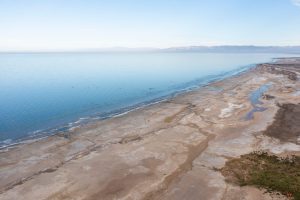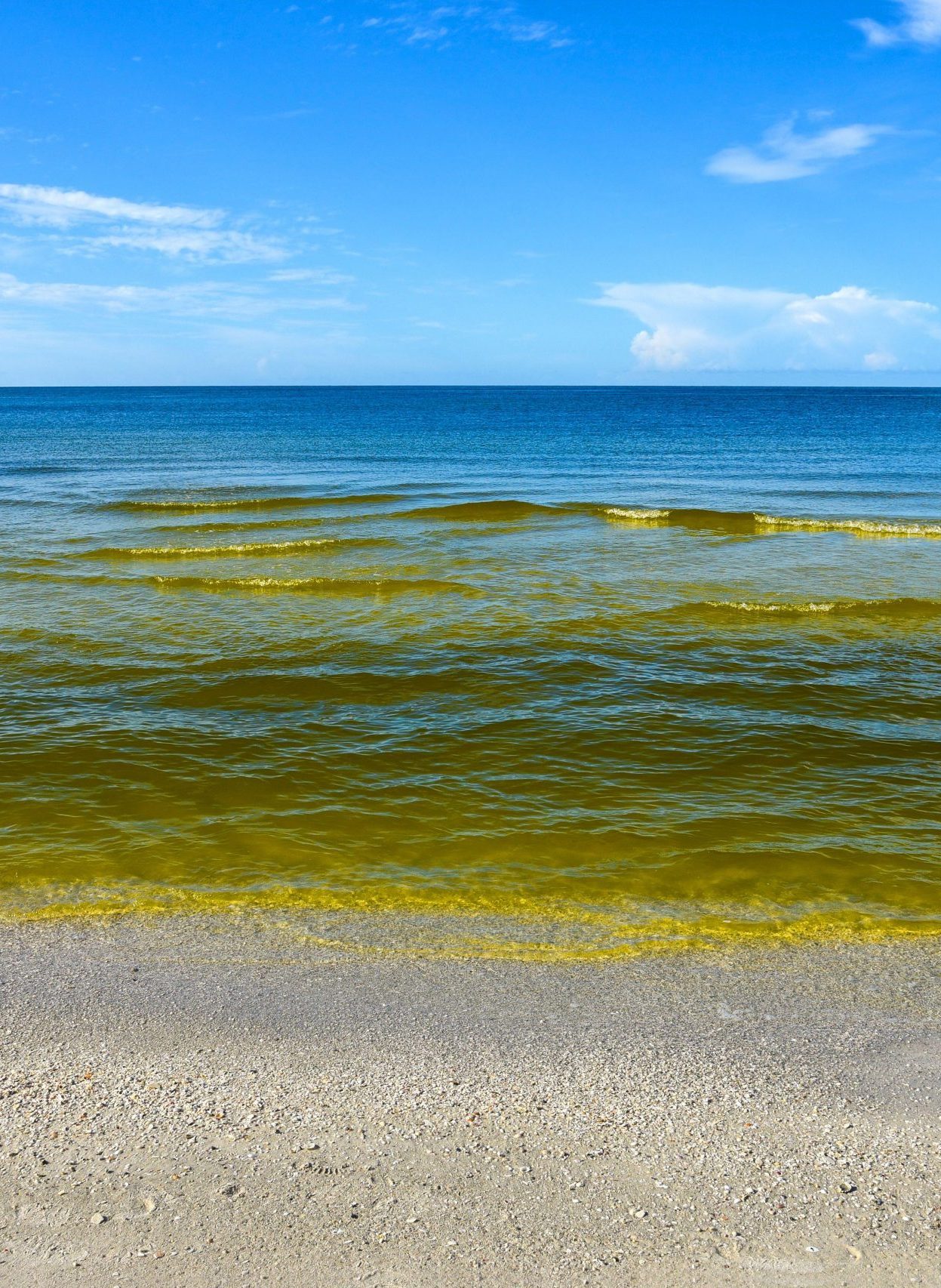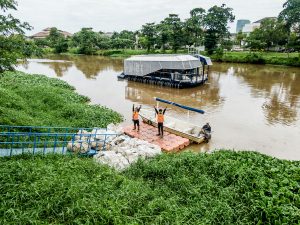In the chilly gloom of the Californian seabed, thousands of barrels ooze a banned chemical. Some date back to the 1940s when the first was dumped off the coast. In March this year, researchers found that the chemical, DDT, has barely broken down, remaining as toxic as it was 80 years ago.
DDT (dichlorodiphenyltrichloroethane) is an insecticide that was widely used in agriculture until being banned – in the United States in 1972 and globally in 2001 – due to concerns about health impacts on wildlife and people. Its dense chemical bonds can resist degradation for decades.
Researchers now worry that dredging or storms could cause this polluted stretch of seafloor off the Los Angeles coast to release toxic plumes, threatening sea life and those who eat it.
Plastic gets the limelight when it comes to ocean pollution, but chemicals pose “a major threat, one that we’re probably consistently underestimating,” says Alex Rogers, a marine ecologist at the University of Oxford, and science director with REV Ocean, a research non-profit working on solutions to ocean challenges. The problem goes far beyond legacy pollutants like those barrels of DDT. Today, around 350,000 synthetic chemicals are widely used in manufacturing. They are embedded in our everyday lives in pharmaceuticals, cosmetics, cleaning products, electrical goods, textiles, furniture and other products. Ninety-five percent of all manufactured items now contain synthetic chemicals of some kind.
Their diverse applications have revolutionised our lives, but they can also endanger marine life and indeed ecosystems. Reaching the sea by a variety of routes, whether dishwashing liquid down the drain, oily wastewater dumped by tankers at sea, or even chemical-infused toilet paper, their presence and potential impacts are far-reaching. Synthetic chemicals have now been found in the remote Arctic and deep ocean trenches. Research by the EU suggests that 75% of the north-east Atlantic, 87% of the Mediterranean, and 96% of the Baltic Sea is contaminated with synthetic substances and heavy metals.
“We’re in a situation where more and more of these chemicals are being produced,” Rogers says. When pharmaceuticals are included, the chemical industry is the world’s second largest manufacturing industry. As it continues churning out new varieties, scientists, campaigners and policymakers are asking with growing urgency: what exactly are these chemicals doing to the ocean – and to us?
Lack of data
We actually know little about the impacts of most chemical pollutants on marine life. Understanding has been hampered by their mind-boggling diversity, complex makeup and variable properties. The growing sophistication of consumer goods means individual products are often manufactured using dozens of synthetic chemicals, making ocean impacts even trickier to untangle.
An analysis in 2021 revealed that across some 130,000 studies on the ecological impacts of synthetics, just 65 chemicals dominated the literature. Furthermore, there’s no public information available on 120,000 of the 350,000 chemicals produced worldwide. These data gaps were mentioned in a 2022 report produced by Back to Blue, a joint initiative of the Economist and the Nippon Foundation. It was the first attempt to describe the scale of global ocean chemical pollution: “We had the realisation that we hadn’t missed the data. It’s just not there,” says Jessica Brown, co-author of the report, and head of engagement at Back to Blue. “We travelled to the UN Ocean Conference last June, and one of the things that really struck us was that very few people were talking about any kind of pollution other than plastic.”
The little we do know about chemical pollution suggests its threat is far bigger than we realise. Of particular concern are persistent organic pollutants. “POPs” cover a diversity of chemicals that include the likes of DDT and polychlorinated biphenyls (PCBs), a group of compounds used as lubricants and coolants in electrical equipment until, like DDT, they were regulated in most countries. But the problem is that these chemicals, along with all other POPs, share two traits: persistence, and a tendency to accumulate in fatty tissues.
In the ocean, they’re steadily “biomagnified” up the food chain. Rogers explains: “Many large predators are long-lived, and so as they’re continuously feeding on contaminated prey, they’re building up larger and larger concentrations of these toxic compounds in their own bodies.” These chemicals have been linked to cancers, fertility problems, and other conditions. In the blubber of Europe’s orca and bottlenose dolphins, PCBs have accumulated to such high levels that many animals have been left unable to breed, threatening the populations with extinction.
Dozens of POPs are now banned under the Stockholm Convention. But their persistence means that even long-banned chemicals like PCBs and DDT still circulate at “worrisome levels,” says John Stegeman, a marine toxicologist at the Woods Hole Oceanographic Institution. It’s the same problem with other POPs like per- and poly-fluoroalkyl substances (PFAS). Some PFAs were only banned under the convention in 2019. “So like PCBs they will be around for a long, long time,” Stegeman says.
By hitching a ride on highly buoyant rafts of plastic waste, POPs have now reached the far corners of the ocean. Meanwhile, the 14 million tons of plastic that flood the ocean every year may itself also be morphing into a significant source of chemical pollution. “We have been working on industrial chemical pollution, many of us for over 20 years now,” says Ninja Reineke, head of science at CHEM Trust, a UK–German charity campaigning for better chemicals regulations. “And then at some stage, plastic pollution became the hot topic. But many of the things we’ve been concerned about for years are actually plastic additives,” Reineke says. These include PFAS, phthalates (plasticisers), and bisphenol A (BPA), which are infused into plastics to, among other things, make them water-repellent, flexible and clear. Such chemicals are endocrine disruptors and have been found to affect reproduction in molluscs, crustaceans, insects, fish and amphibians, and development in crustaceans and amphibians. They leach out of ocean plastic as it degrades. “There’s a lot we don’t know about that, but, overall, plastics are also a matter of chemical pollution,” Stegeman adds.
The data on marine chemical pollutants is typically limited to the effects of certain chemicals on certain species. What they’re doing at ecosystem scales is generally unknown. An exception is synthetic nitrogen fertilisers. When washed off farmland into the sea, these nutrient-rich chemical mixtures can trigger algal blooms. When the algae dies, the bacteria that break it down consume most of the oxygen in the water column, choking out marine life. This causes die-offs of fish, dolphins and seals, leaving dead zones – some so large they can be seen from space. The recurring dead zone in the Gulf of Mexico, caused by nutrient pollution flowing out of the Mississippi River, spans about 10,000 square kilometres. It is thought to cost the US about $82 million a year in lost fisheries and tourism.
Human health
That taps into a big unknown: the human health impact of all this chemical pollution flushing into the sea. Global estimates show that pollution in general – including by chemicals – caused up to nine million premature deaths in 2019. Marine pollution mainly enters our bodies through seafood. As Stegeman points out, three billion or so people rely on marine species for protein.
Seafood may contain toxins from algal blooms, and potentially plastic-associated chemicals, according to a major recent report into the health impact of plastics. There’s also a risk of consuming mercury and PCBs that accumulate in fish. These chemicals can cause developmental problems in foetuses, and cardiovascular disease and dementia in adults, a recent literature review found. The review, co-authored by Stegeman, explored the connection between rising ocean pollution and human health. It also found that coal-burning is a major source of mercury pollution in the ocean, having been carried there by the wind. Marine chemical pollution may even enter our bodies if we inhale particles suspended in sea spray. “This is not just a story about the ocean but about us, because we are also exposed,” says Rogers.
The problem shows few signs of abating. The UN’s 2019 Global Chemical Outlook estimated that sales of synthetic chemicals will likely double by 2030. Unchecked production is fuelling increasingly unnecessary usage, Rogers believes. He recalls once seeing benzophenones – a chemical commonly found in sunscreens and known to kill young corals – in a body wash, there to prevent the coloured gel within from losing its hue in sunlight. “To me this is a really trivial use of a chemical which is potentially harmful.”
Scientists are also worried about the cocktail effect of thousands of volatile chemicals mixing in the sea, and how this stew will react in our warming and acidifying ocean. “This is an issue that the scientific community has to come to grips with in order to really appreciate the magnitude of potential harm,” Stegeman says. Meanwhile, production is moving to countries with less environmental regulation, increasing the chances that pollution will reach the sea.
A 2022 study argued that chemical production has in fact already crossed the safe planetary threshold. “The rate at which these pollutants are appearing in the environment far exceeds the capacity of governments to assess the risk, let alone control potential problems,” its authors wrote.
Who’s in charge?
Can regulation help curb the spread? Currently, aspects of global chemical pollution are covered by a patchwork of voluntary initiatives, agreements, national and state laws, and treaties. The Basel, Rotterdam and Stockholm conventions respectively control the dumping and the trade of hazardous wastes, and the production of certain chemical groups. Beyond these, there’s the European Union’s REACH legislation, which, significantly, puts the burden of responsibility on chemical companies to check their safety before use, instead of leaving researchers and governments scrambling to do damage control once these chemicals have been released into the wild.
People are making vast quantities of money knocking out stuff that’s causing long-term harm to our marine ecosystemsAlex Rogers, marine ecologist at the University of Oxford
“When REACH was created, there was this feeling that [chemical production] is just getting out of control. We don’t know enough about the uses, the properties even, and authorities shouldn’t have to chase that all the time,” says Reineke, whose organisation CHEM Trust has been advising on changes to the European law that would increase controls on endocrine-disrupting chemicals. They’re also pushing for substances with similar properties to be systematically regulated in groups, rather than banned one-by-one. Individual banning is a slow process that can lead to “regrettable substitution”, where a prohibited substance is simply replaced by a chemically similar version – “jumping from the frying pan into the fire” as Reineke puts it.
Another potential regulatory bright spot is the global plastics treaty currently being negotiated through the UN. When countries meet in May for the next stage of talks on what will go into the final treaty, one possibility on the agenda is reducing harmful additives and chemicals in plastics manufacturing. Promisingly, this legally binding treaty is likely to take a whole-lifecycle view of plastics and their environmental impact.
But the relatively slow pace of legislative change means there may be limits to what top–down regulation can achieve alone. “So much of the chemistry we’re working with was designed 40 to 50 years ago, when health, safety and environment weren’t part of the consideration,” says Joel Tickner, professor at the University of Massachusetts Lowell Centre for Sustainable Production. Changing this will require foundational shifts in how chemicals are manufactured, and innovation to create substitutes that don’t yet exist, he explains.
This is where industry could play a role in escaping the toxic chemical bind. Tickner founded the Green Chemistry & Commerce Council, a network of over 100 businesses working to develop chemicals that break down in the environment, for instance. In fact, safer alternatives already exist for many chemicals, according to Tickner; they just need routes into the market. “The renewable energy market – it’s taken subsidisation to do it. We’re going to have to subsidise the transition [to green chemistry].”
Curbing marine chemical pollution is a momentous problem that may ultimately require governments, industry and consumers to join forces. In the meantime, those barrels of DDT continue seeping on the Californian seafloor, a cautionary reminder of what awaits us if we don’t act. “People are making vast quantities of money knocking out stuff that’s causing long-term harm to our marine ecosystems. Some of these chemicals are actually a contributory factor to extinction risk,” Rogers says. “So, there’s a whole moral aspect to this.”












